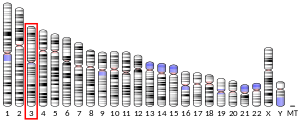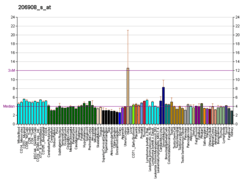CLDN11
Claudin-11 is a protein that in humans is encoded by the CLDN11 gene.[5][6][7] It belongs to the group of claudins and was the first member of the family to be knocked out in mice, thereby demonstrating the central role of claudins for intramembranous strands observed in freeze-fracture images.[8]
| CLDN11 | |||||||||||||||||||||||||
|---|---|---|---|---|---|---|---|---|---|---|---|---|---|---|---|---|---|---|---|---|---|---|---|---|---|
| Identifiers | |||||||||||||||||||||||||
| Aliases | CLDN11, OSP, OTM, claudin 11 | ||||||||||||||||||||||||
| External IDs | OMIM: 601326 MGI: 106925 HomoloGene: 4093 GeneCards: CLDN11 | ||||||||||||||||||||||||
| |||||||||||||||||||||||||
| |||||||||||||||||||||||||
| |||||||||||||||||||||||||
| |||||||||||||||||||||||||
| Orthologs | |||||||||||||||||||||||||
| Species | Human | Mouse | |||||||||||||||||||||||
| Entrez | |||||||||||||||||||||||||
| Ensembl | |||||||||||||||||||||||||
| UniProt | |||||||||||||||||||||||||
| RefSeq (mRNA) | |||||||||||||||||||||||||
| RefSeq (protein) | |||||||||||||||||||||||||
| Location (UCSC) | Chr 3: 170.42 – 170.45 Mb | Chr 3: 31.15 – 31.16 Mb | |||||||||||||||||||||||
| PubMed search | [3] | [4] | |||||||||||||||||||||||
| Wikidata | |||||||||||||||||||||||||
| |||||||||||||||||||||||||
Function
The protein encoded by this gene belongs to the claudin family of tight junction associated proteins and is a major component of central nervous system myelin that is necessary for normal CNS function,[9] hearing,[10] and spermatogenesis.[8] There is growing evidence that the protein determines the permeability between layers of myelin sheaths[11] and, with its expression highly regulated during development, may play an important role in cellular proliferation and migration. In addition, the protein is a candidate autoantigen in the development of autoimmune demyelinating disease.[7] Finally, experiments in Cldn11-null mice demonstrate that behavioral phenotypes in open field tests, as well as defects in sound lateralization, accompany changes in neurotransmitter levels in the amygdala/ventral hippocampus and auditory brainstem. This study reveals a molecular mechanism by which changes to myelin membrane properties in the absence of degenerative pathology, could lead to neuropsychiatric disease in humans.[12]
References
- GRCh38: Ensembl release 89: ENSG00000013297 - Ensembl, May 2017
- GRCm38: Ensembl release 89: ENSMUSG00000037625 - Ensembl, May 2017
- "Human PubMed Reference:". National Center for Biotechnology Information, U.S. National Library of Medicine.
- "Mouse PubMed Reference:". National Center for Biotechnology Information, U.S. National Library of Medicine.
- Bronstein JM, Kozak CA, Chen XN, Wu S, Danciger M, Korenberg JR, Farber DB (June 1996). "Chromosomal localization of murine and human oligodendrocyte-specific protein genes". Genomics. 34 (2): 255–7. doi:10.1006/geno.1996.0278. PMID 8661061.
- Bronstein JM, Popper P, Micevych PE, Farber DB (September 1996). "Isolation and characterization of a novel oligodendrocyte-specific protein". Neurology. 47 (3): 772–8. doi:10.1212/wnl.47.3.772. PMID 8797478.
- "Entrez Gene: CLDN11 claudin 11 (oligodendrocyte transmembrane protein)".
- Gow A, Southwood CM, Li JS, Pariali M, Riordan GP, Brodie SE, Danias J, Bronstein JM, Kachar B, Lazzarini RA (December 1999). "CNS myelin and sertoli cell tight junction strands are absent in Osp/claudin-11 null mice". Cell. 99 (6): 649–59. doi:10.1016/S0092-8674(00)81553-6. PMID 10612400.
- Devaux J, Gow A (December 2008). "Tight junctions potentiate the insulative properties of small CNS myelinated axons". The Journal of Cell Biology. 183 (5): 909–21. doi:10.1083/jcb.200808034. PMC 2592840. PMID 19047465.
- Gow A, Davies C, Southwood CM, Frolenkov G, Chrustowski M, Ng L, Yamauchi D, Marcus DC, Kachar B (August 2004). "Deafness in Claudin 11-null mice reveals the critical contribution of basal cell tight junctions to stria vascularis function". The Journal of Neuroscience. 24 (32): 7051–62. doi:10.1523/JNEUROSCI.1640-04.2004. PMC 4615685. PMID 15306639.
- Denninger AR, Breglio A, Maheras KJ, LeDuc G, Cristiglio V, Demé B, Gow A, Kirschner DA (October 2015). "Claudin-11 Tight Junctions in Myelin Are a Barrier to Diffusion and Lack Strong Adhesive Properties". Biophysical Journal. 109 (7): 1387–97. doi:10.1016/j.bpj.2015.08.012. PMC 4601091. PMID 26445439.
- Maheras KJ, Peppi M, Ghoddoussi F, Galloway MP, Perrine SA, Gow A (February 2018). "Absence of Claudin 11 in CNS Myelin Perturbs Behavior and Neurotransmitter Levels in Mice". Scientific Reports. 8 (1): 3798. doi:10.1038/s41598-018-22047-9. PMC 5830493. PMID 29491447.
Further reading
- Kniesel U, Wolburg H (February 2000). "Tight junctions of the blood-brain barrier". Cellular and Molecular Neurobiology. 20 (1): 57–76. doi:10.1023/A:1006995910836. PMID 10690502.
- Bronstein JM, Tiwari-Woodruff S, Buznikov AG, Stevens DB (March 2000). "Involvement of OSP/claudin-11 in oligodendrocyte membrane interactions: role in biology and disease". Journal of Neuroscience Research. 59 (6): 706–11. doi:10.1002/(SICI)1097-4547(20000315)59:6<706::AID-JNR2>3.0.CO;2-D. PMID 10700007.
- Heiskala M, Peterson PA, Yang Y (February 2001). "The roles of claudin superfamily proteins in paracellular transport". Traffic. 2 (2): 93–8. doi:10.1034/j.1600-0854.2001.020203.x. PMID 11247307.
- Tsukita S, Furuse M, Itoh M (April 2001). "Multifunctional strands in tight junctions". Nature Reviews. Molecular Cell Biology. 2 (4): 285–93. doi:10.1038/35067088. PMID 11283726.
- Tsukita S, Furuse M (October 2002). "Claudin-based barrier in simple and stratified cellular sheets". Current Opinion in Cell Biology. 14 (5): 531–6. doi:10.1016/S0955-0674(02)00362-9. PMID 12231346.
- González-Mariscal L, Betanzos A, Nava P, Jaramillo BE (January 2003). "Tight junction proteins". Progress in Biophysics and Molecular Biology. 81 (1): 1–44. doi:10.1016/S0079-6107(02)00037-8. PMID 12475568.
- Shafit-Zagardo B, Kress Y, Zhao ML, Lee SC (December 1999). "A novel microtubule-associated protein-2 expressed in oligodendrocytes in multiple sclerosis lesions". Journal of Neurochemistry. 73 (6): 2531–7. doi:10.1046/j.1471-4159.1999.0732531.x. PMID 10582615.
- Bronstein JM, Chen K, Tiwari-Woodruff S, Kornblum HI (May 2000). "Developmental expression of OSP/claudin-11". Journal of Neuroscience Research. 60 (3): 284–90. doi:10.1002/(SICI)1097-4547(20000501)60:3<284::AID-JNR2>3.0.CO;2-T. PMID 10797530.
- Tiwari-Woodruff SK, Buznikov AG, Vu TQ, Micevych PE, Chen K, Kornblum HI, Bronstein JM (April 2001). "OSP/claudin-11 forms a complex with a novel member of the tetraspanin super family and beta1 integrin and regulates proliferation and migration of oligodendrocytes". The Journal of Cell Biology. 153 (2): 295–305. doi:10.1083/jcb.153.2.295. PMC 2169454. PMID 11309411.
- Suzuki H, Fukunishi Y, Kagawa I, Saito R, Oda H, Endo T, Kondo S, Bono H, Okazaki Y, Hayashizaki Y (October 2001). "Protein-protein interaction panel using mouse full-length cDNAs". Genome Research. 11 (10): 1758–65. doi:10.1101/gr.180101. PMC 311163. PMID 11591653.
- Liu F, Koval M, Ranganathan S, Fanayan S, Hancock WS, Lundberg EK, Beavis RC, Lane L, Duek P, McQuade L, Kelleher NL, Baker MS (February 2016). "Systems Proteomics View of the Endogenous Human Claudin Protein Family". Journal of Proteome Research. 15 (2): 339–59. doi:10.1021/acs.jproteome.5b00769. PMC 4777318. PMID 26680015.
External links
- Human CLDN11 genome location and CLDN11 gene details page in the UCSC Genome Browser.




